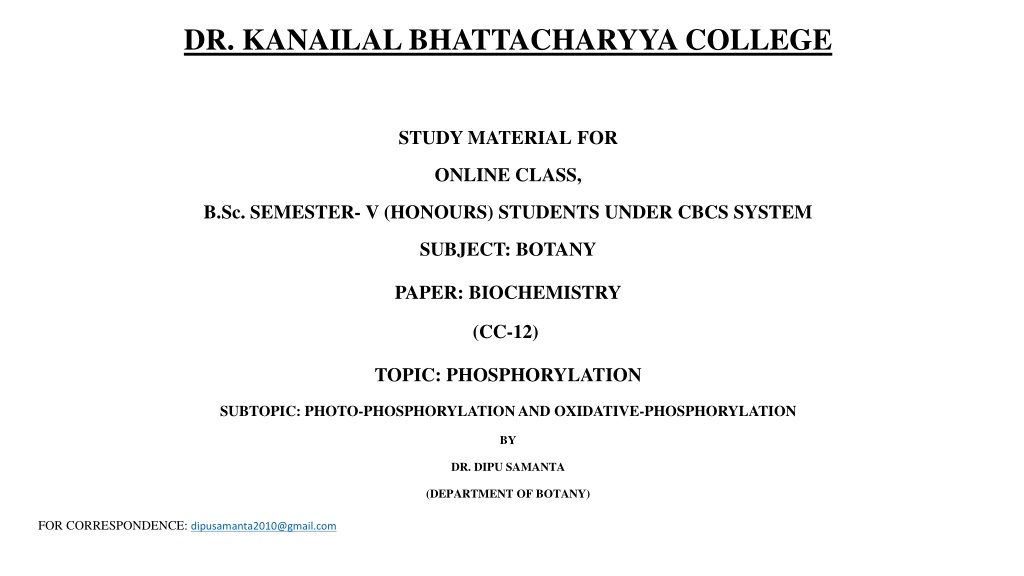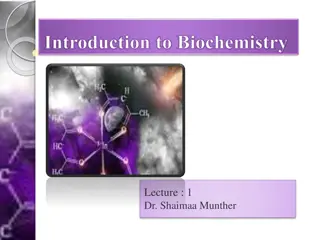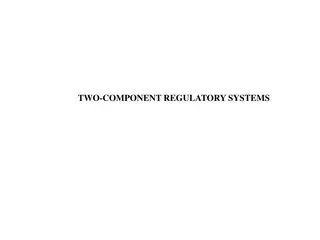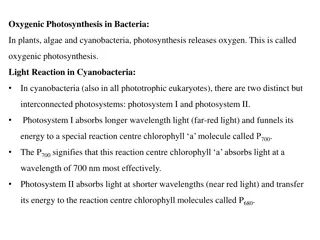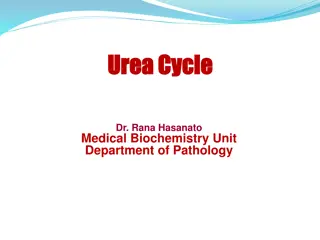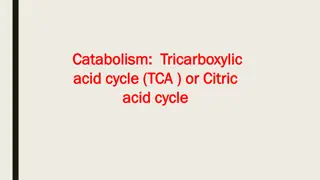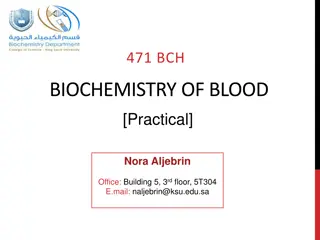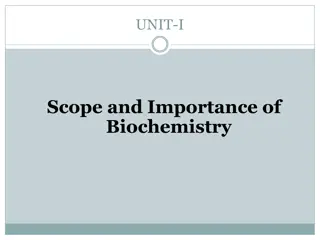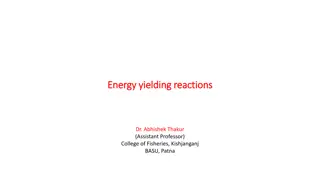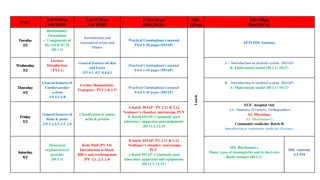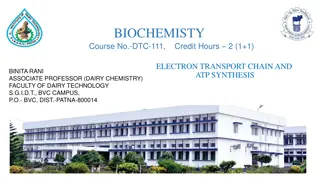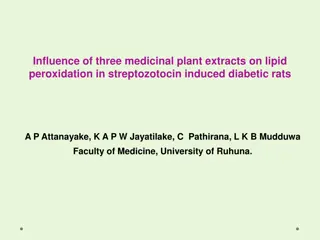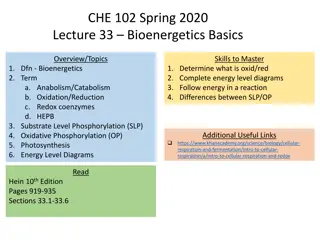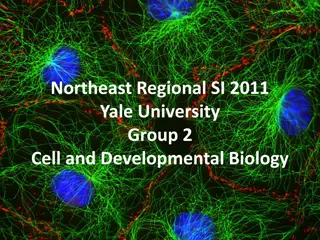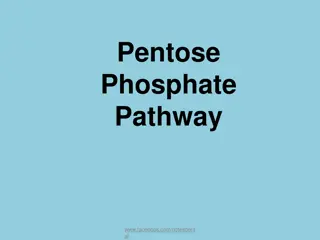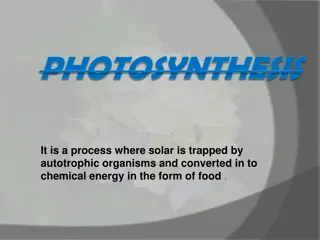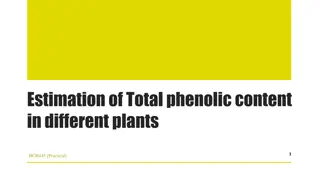Understanding Photophosphorylation and Oxidative Phosphorylation in Biochemistry
Phosphorylation is the process of ATP production from ADP, occurring in two main forms - Photophosphorylation and Oxidative Phosphorylation. Photophosphorylation involves utilizing light energy to convert ADP to ATP, with two types: Cyclic and Non-Cyclic. Oxidative Phosphorylation uses energy from the electron transport chain to produce ATP through reduction of O2 to H2O. Detailed processes and electron carrier pathways are explained for both types of phosphorylation.
Download Presentation

Please find below an Image/Link to download the presentation.
The content on the website is provided AS IS for your information and personal use only. It may not be sold, licensed, or shared on other websites without obtaining consent from the author. Download presentation by click this link. If you encounter any issues during the download, it is possible that the publisher has removed the file from their server.
E N D
Presentation Transcript
DR. KANAILAL BHATTACHARYYA COLLEGE STUDY MATERIALFOR ONLINE CLASS, B.Sc. SEMESTER- V (HONOURS) STUDENTS UNDER CBCS SYSTEM SUBJECT: BOTANY PAPER: BIOCHEMISTRY (CC-12) TOPIC: PHOSPHORYLATION SUBTOPIC: PHOTO-PHOSPHORYLATION AND OXIDATIVE-PHOSPHORYLATION BY DR. DIPU SAMANTA (DEPARTMENT OF BOTANY) FOR CORRESPONDENCE: dipusamanta2010@gmail.com
Phosphorylation Phosphorylation is the process of production of ATP from ADP. It is of two types: Photophosphorylation and Oxidative Phosphorylation. Photophosphorylation is the process of utilizing light energy from photosynthesis to convert ADP to ATP. There are two types of Photophosphorylation . 1. Cyclic Photophosphorylation and 2. Non-Cyclic Photophosphorylation. Oxidative phosphorylation is the process by which energy from electron transport chain is used to make ATP. Oxidative phosphorylation involves the reduction of O2to H2O.
Type 1. Cyclic Photophosphorylation: It is a process of photophosphorylation in which an electron expelled by the excited photo-centre is returned to it after passing through a series of electron carriers. Cyclic photophosphorylation is performed by photosystem I only. Its photo-centre P700extrudes an electron with a gain of 23 kcal/mole of energy after absorbing a photon of light (hv). After losing the electron the photo-centre becomes oxidized. The expelled electron passes through a series of carriers including X or A0(a special P700chlorophyll molecule), A, (a quinone), FeS complexes (FeSX, FeSA, FeSB), ferredoxin, (Fd), plastoquinone (PQ), cytochrome b f complex and plastocyanin before returning to photo centre. Fig. Cyclic Photophosphorylation While over the cytochrome complex, the electron energises passage of protons to create a proton gradient for synthesis of ATP from ADP and inorganic phosphate.
Type 2. Non-Cyclic Photophosphorylation: It is the process of photophosphorylation in which the electron expelled by the excited photo-centre does not return to it. Non-cyclic photophosphorylation is carried out in collaboration of both photosystems I and II. Electron released during photolysis of water is picked up by photo-centre of PS II called P680. The same is extruded out when the photo Centre absorbs light energy (hv). It passes through a series of electron carriers phaeophytin, PQ, cytochrome b f complex and plastocyanin. While passing over cytochrome complex, the electron loses sufficient energy for the synthesis of ATP. The electron is handed over to photo Centre P700of PS I by plastocyanin. P700extrudes the electron after absorbing light energy. The extruded electron passes through special chlorophyll X, Fe-S, ferredoxin, to finally reach NADP+. The latter then combines with H+(released during photolysis) with the help of NADP- reductase to form NADPH. This is called Z scheme due to its characteristic zig-zag shape based on redox potential of different electron carriers .
Oxidative Phosphorylation: Oxidative phosphorylation is the process by which energy from electron transport chain is used to make ATP, and is the culmination of energy yielding metabolism in aerobic organisms. Oxidative phosphorylation involves the reduction of O2to H2O with electrons donated by NADH and FADH2, and equally occurs in light or darkness.
Chemiosmotic Hypothesis and Oxidative Phosphorylation: According to chemiosmotic hypothesis the electron transport chain is organized so that protons move outward from the mitochondrial matrix to inter-membrane space.
Generation of Proton Motive Force (PMF): Proton movement may result either from different complexes or from the action of special proton pumps that derive their energy from electron transport resulting in proton motive force (PMF) composed of a gradient of protons and a membrane potential due to the unequal distribution of charges. When O2is reduced to H2O after accepting electrons transferred from electron transport chain, it requires proton (H+) from the cytoplasm to complete the reaction. These protons originate from the dissociation of water into H+and OH . The use of H+in the reduction of O2to H2O and the extrusion of H+outside the membrane during electron transport chain cause a net accumulation of OH on the inside of the membrane. Despite their small size, because they are charged, neither H+nor OH freely passes through the membrane, and so equilibrium cannot be spontaneously restored on both sides of membrane. This non-equilibrium state of H+and OH on opposite sides of the membrane results in the generation of a pH gradient and an electrochemical potential across the membrane, with the inside of the membrane (cytoplasm side) electrically negative and alkaline, and the outside of the membrane electrically positive and acidic. This pH gradient and electrochemical potential cause the membrane to be energised.
Proton Motive Force and ATP Synthesis: Proton motive force-derived ATP synthesis involves a catalyst, which is a large membrane enzyme complex called ATP synthase or ATPase for short. Fig. ATPase
The ATPase (1) A multi-subunit head piece called F1located on mitochondrial matrix side (in eukaryotes) and on cytoplasmic side (in prokaryotes) and (2) A proton conducting channel called F0that resides in the inner membrane of mitochondrion (in eukaryotes) and in plasma membrane (in prokaryotes) and spans the membrane. known biological motor. F1, is the catalytic complex responsible for the inter conversion of ADP + Pi (inorganic phosphate) and ATP, and consists of five different polypeptides present as an 3 3 complex. F0is integrated in the membrane and consists of three polypeptides in an ab2c12complex. 3, 3, 2 and 12 denote the numerical numbers of , , b and c, respectively. The ATP synthesis takes place at the F1/F0ATPase, which is the smallest
Inhibition of Oxidative Phosphorylation (ATP Synthesis): Many chemicals inhibit the synthesis of ATP and can even kill cells to sufficiently high concentrations. Inhibitors directly block electron transport chain. The antibiotic piericidin competes with coenzyme Q; the antibiotic antimycin. A blocks electron transport between cytochromes b, and c, and both carbon monoxide (CO) and cyanide (CN ) bind tightly to certain cytochromes and prevent their functioning.
Differences between oxidative phosphorylation and photophosphorylation Points Oxidative phosphorylation Photophosphorylation Site It occurs in mitochondria It occurs in chloroplast It involves the reduction of O2to H2O with electrons donated by NADH and FADH2.O2will be the final electron acceptor. It involves the oxidation of H2O to O2, with NADP. NADP acts as a final electron acceptor. Process chemistry Occurrence It occurs in aerobic cells. It occurs in photosynthetic cell It occurs well in light and dark conditions. Requirement of light It occurs only in light condition Light energy is converted into ATP Energy Chemical energy is converted into ATP
